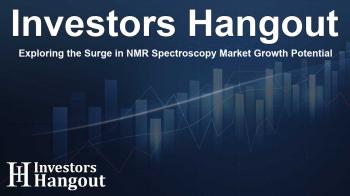Exploring the Surge in NMR Spectroscopy Market Growth Potential

The Expansion of NMR Spectroscopy Market
The NMR spectroscopy market is rapidly evolving, with projections indicating that it will reach a valuation of USD 2.08 billion by 2032. This impressive growth is primarily driven by the increasing reliance on detailed molecular structure analysis within the pharmaceutical and biotechnology industries. In 2023, the market was valued at an encouraging USD 1.31 billion, reflective of a strong compound annual growth rate (CAGR) of 5.26% expected between 2024 and 2032.
Key Drivers of Market Growth
A significant surge in global demand for accurate and reliable methods of molecular analysis is evident. Industries such as pharmaceuticals, chemicals, and biotech are investing heavily in advanced technologies that permit in-depth analysis of complex molecular structures. Additionally, government and private investments are boosting scientific research initiatives, further propelling market expansion.
Technological Advancements Fueling Adoption
Recent advancements in NMR technology have resulted in the development of high-field NMR systems, which are crucial for the pharmaceutical research and development landscape. The non-destructive nature of these systems enhances their appeal, allowing scientists to analyze samples without altering their properties. This capability is invaluable for pharmaceutical companies that prioritize quality control and rigorous testing methodologies.
Market Segmentation Insights
The NMR spectroscopy market can be segmented based on various factors including product type, application, and end-user segments. In 2023, the instruments segment represented a dominant share, accounting for 80.3% of the market. High-field NMR spectroscopy is highly favored, capturing 88.7% of the market share due to its superior capabilities in delivering precise, high-resolution data essential for drug development and academic research.
End-User Segmentation
Academic institutions emerge as the leading end-users, with a noteworthy 46.9% share in the market. These institutions leverage NMR technology for educational purposes and groundbreaking research, further enhanced by government grants that facilitate access to advanced instruments. Collaborations between academia and pharmaceutical firms are fostering innovation in drug discovery and compound identification.
Regional Market Performance
In terms of geographical distribution, North America currently leads the NMR spectroscopy market with a 38% share. This region benefits from a robust pharmaceutical sector, substantial investment in healthcare research and development, and a well-established network of leading research universities. In contrast, Europe, particularly Germany and the UK, remains a strong contender due to significant investments in life sciences and collaborative efforts between universities and global instrumentation manufacturers.
The Asia-Pacific region is anticipated to exhibit the most rapid growth, propelled by escalated investments in R&D among countries like China and India, aimed at enhancing laboratory infrastructure and fostering innovative capabilities in biotechnologies.
Notable Market Players
Several key players dominate the NMR spectroscopy landscape, including:
- Bruker Corporation - known for its AVANCE NEO series and other high-performance instruments.
- Thermo Fisher Scientific - recognized for products like the picoSpin Series.
- JEOL Ltd. - which provides various advanced NMR systems.
- Oxford Instruments - famous for their reliable benchtop NMR solutions.
- Nanalysis Corp. - focusing on compact, high-quality NMR instruments.
- Magritek - specializing in Spinsolve Series devices.
- Niumag Corporation - renowned for its MicroMR series.
- QoneTec AG - well-regarded for its probes and accessories.
- Cosa Xentaur and Tel Atomic Incorporated - both contributing significantly to the educational NMR systems market.
- TecMag - offering high-performance Redstone NMR spectrometers.
Recent Developments in NMR Technology
Recent innovations in this field include Bruker Corporation's latest Fourier 80 benchtop NMR, which marries high performance with a compact design. Additionally, collaborations, such as the one by Thermo Fisher Scientific with multiple U.S. universities, aim to enhance metabolomics tools for advancing cancer biomarker research.
Frequently Asked Questions
What is the forecast for the NMR spectroscopy market by 2032?
The NMR spectroscopy market is projected to reach USD 2.08 billion by the year 2032.
What are the main drivers of growth for this market?
The growth is primarily driven by the increasing demand for accurate molecular analysis in pharmaceuticals and the investment in scientific research.
Which segment occupies the largest market share?
Instruments represent the largest segment, constituting over 80% of the market share in 2023.
How does NMR technology help in drug development?
NMR technology provides precise molecular data that is essential for drug testing, chemical compound analysis, and ensuring quality control.
What regions are leading in NMR spectroscopy adoption?
North America is the largest market for NMR spectroscopy, followed by Europe and the rapidly growing Asia-Pacific region.
About The Author
Contact Addison Perry privately here. Or send an email with ATTN: Addison Perry as the subject to contact@investorshangout.com.
About Investors Hangout
Investors Hangout is a leading online stock forum for financial discussion and learning, offering a wide range of free tools and resources. It draws in traders of all levels, who exchange market knowledge, investigate trading tactics, and keep an eye on industry developments in real time. Featuring financial articles, stock message boards, quotes, charts, company profiles, and live news updates. Through cooperative learning and a wealth of informational resources, it helps users from novices creating their first portfolios to experts honing their techniques. Join Investors Hangout today: https://investorshangout.com/
The content of this article is based on factual, publicly available information and does not represent legal, financial, or investment advice. Investors Hangout does not offer financial advice, and the author is not a licensed financial advisor. Consult a qualified advisor before making any financial or investment decisions based on this article. This article should not be considered advice to purchase, sell, or hold any securities or other investments. If any of the material provided here is inaccurate, please contact us for corrections.

